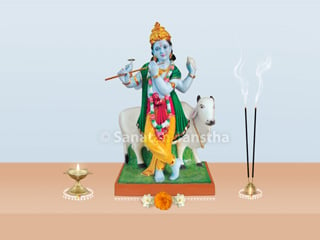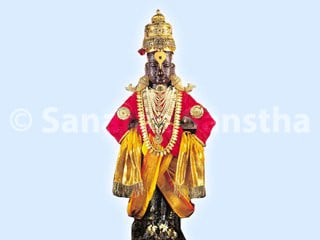
Shri Vishnu
In the ancient Hindu spiritual traditions, worshipping various Deities in the temple is one of the most commonly seen practices. If we observe carefully, we will see that different Deities are worshipped differently. The mantras chanted to please different Deities are different as well.Shri Vishnu has been worshipped since the Vedic period. The greatest Vaishnav is Deity Shiva and the greatest Shaiva is Shri Vishnu, because they worship each other. The following article provides information on the ritualistic worship of Shri Vishnu.
1. Worship according to the Vaishnav sect
Like all other Deities, Shri Vishnu’s worship is also performed with sixteen items (Shodashopchar puja, Shodash = sixteen). It will be useful to understand the three favourite offerings to Shri Vishnu.
A. Tulsi leaves are essential in the worship of Shri Vishnu
B. He likes lotus flowers a lot.
C. Offerings like kheer (A sweet made from milk and rice or vermicelli) or sheera (A sweet made from semolina, pure ghee and sugar) are Shri Vishnu’s favourite dishes.
2. Worshipping Shri Vishnu by different names
Each month, Shri Vishnu should be worshipped by different Names on the 12th day (Dwadashi) of the Lunar calendar. Let us understand this in detail.
Lunar month |
English month |
Name of Shri Vishnu |
|
|
1 |
Margashirsha |
December |
Keshav |
|
2 |
Poush |
January |
Narayan |
|
3 |
Magha |
February |
Madhav |
|
4 |
Phalgun |
March |
Govind |
|
5 |
Chaitra |
April |
Vishnu |
|
6 |
Vaishakh |
May |
Madhusudan |
|
7 |
Jyeshtha |
June |
Trivikram |
|
8 |
Ashadha |
July |
Vaman |
|
9 |
Shravan |
August |
Shridhar |
|
10 |
Bhadrapad |
September |
Hrushikesh |
|
11 |
Ashwin |
October |
Padmanabh |
|
12 |
Kartik |
November |
Damodar |
3. Some important points to be
considered while worshipping Shri Vishnu
A. The Idol should be made of gold.
B. The Idol should be draped in a white cloth.
C. It should be installed on a kalash.
D. The worship should end with the chanting of the twelve lettered mantra, (ॐ नमो भगवते वासुदेवाय ।).
E. Every month, different flowers and fruits should be offered.
Note : Devotees treat Shri Vishnu as a human to the extent that in worshipping Him it is said – ‘Shri Vishnu is eating now, He is sleeping etc.’. During the times of Shri Vishnu eats or sleeps, the doors of His temple are kept closed.
4. Significance of tulsi in the worship of Shri Vishnu
It is said that during the ritual of worship, the Deity is offered that which the Deity likes; for example, Shri Ganapati likes red flowers, Deity Shiva likes bel leaves, Shri Vishnu likes tulsi etc. Then a story is narrated on why the Deity likes that particular offering. In reality, however, superior Deities like Shiva, Vishnu, Ganapati do not have any likes or dislikes. The reasons for offering tulsi to Shri Vishnu are as follows :
A. Devotees perform ritualistic worship of an Idol. However, such worship leads to spiritual progress when the Idol gets charged with Chaitanya (Divine consciousness). To generate this Chaitanya, the specific offering made to that Idol must have more ability than other offerings to attract the pavitraks (Subtlemost particles) of that Deity, which are spread as far as the Maharlok. Tulsi has the maximum ability to attract the pavitraks of Shri Vishnu. That is why, tulsi is offered to Him.
B. यथा हरिस्तथा हरः ।
Meaning : Like Vishnu like Shiva.
On the eleventh day of the Kartik month (corresponding to November), tulsi develops the ability to attract the pavitraks of Deity Shiva, and bel develops the ability to attract the pavitraks of Shri Vishnu. Hence, on the eleventh day of Kartik, Deity Shiva is offered tulsi and Shri Vishnu is offered bel. The psychological analysis of this interchange is to demonstrate the non-duality between Hari (Shri Vishnu) and Har (Deity Shiva).
C. Symbol of detachment
Tulsi is a symbol of detachment. Once while performing Shrikrushna’s tula (Weighing ceremony), the scale remained tilted on Shrikrushna’s side despite many diamonds, gems, gold on the other side. Finally, when the tulsi leaf was placed on all this precious jewellery, the scale tilted the other side. By this, Shrikrushna taught that His favour can be won only by detachment and not with wealth.
5. Worshipping Shri Vishnu with mantras
A. ‘हरे कृष्ण हरे कृष्ण कृष्ण कृष्ण हरे हरे’ : Since the Kalisantaran Upanishad is from Krushnayajurveda, it is also known as Harinamopanishad. This Upanishad was narrated by Brahmadev to Narad at the end of Dwaparyug. In brief, this means that all sins in Kali (referring to Kaliyug, the fourth era of strife) burn by merely chanting the Name of Narayan. This Name comprises the following sixteen words –
॥ हरे राम हरे राम राम राम हरे हरे ॥
॥ हरे कृष्ण हरे कृष्ण कृष्ण कृष्ण हरे हरे ॥
These sixteen words are related to the sixteen parts of the individual and have the ability to liberate the soul. Some people belonging to the Krushna sect chant the second line of the mantra first, then the first line.
B. ‘ॐ नमो नारायणाय’(‘Om Namo Nārāyaṇāya’),‘ॐ नमो भगवते वासुदेवाय’(‘Om Namo Bhagawatē Vāsudēvāya’) and‘ॐ नमो रामाय’(‘Om Namo Rāmāya’) : These are from the Vaishnav Upapuran ‘Kriyayogasar’.
C. The eight-lettered mantra ‘ॐ नमो नारायणाय’ (‘Om Namo Nārāyaṇāya’) is also called the Narayan mantra and the king amongst the mantras. The Vaishnav Saint, Ramanujacharya, had also been initiated with this mantra.

 Maghi Shri Ganesh Jayanti 2025
Maghi Shri Ganesh Jayanti 2025 Greatness of Shani Devta (Planet Saturn)
Greatness of Shani Devta (Planet Saturn) Main places of pilgrimage of Deity Datta
Main places of pilgrimage of Deity Datta Photographic Divine vision of some places which have experienced Shrikrishna’s blissful presence !
Photographic Divine vision of some places which have experienced Shrikrishna’s blissful presence ! Hanuman – a supreme warrior and prompt servitor of Shriram
Hanuman – a supreme warrior and prompt servitor of Shriram Aarti of Vitthal
Aarti of Vitthal